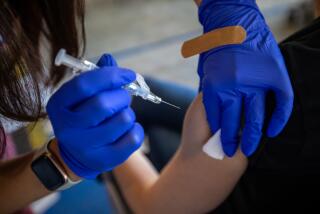Vaccination program credited in fight against whooping cough
Facing an epidemic of whooping cough that led to the deaths of 10 infants in 2010, California public health officials launched a massive vaccination effort and public awareness campaign about the disease.
And on Tuesday, they announced the payoff: no deaths in 2011, a first in two decades. The number of whooping cough, or pertussis, cases also plummeted from about 9,154 in 2010 to 2,795 in 2011, according to the California Department of Public Health.
In Los Angeles County, the number of cases dropped from 1,395 in 2010 to 520 in 2011. Four of the deaths in the state occurred locally.
“Controlling an outbreak is huge,” said Dr. Gil Chavez, deputy director of infectious diseases for the state. “It really happens in a partnership.”
The state worked closely with doctors, hospitals, schools and clinics to get more people vaccinated and to get pertussis identified and treated earlier, Chavez said.
Pertussis is a bacterial disease that infects the respiratory system. Children and adults may have severe coughing with a whooping sound at the end of a spasm. Infants may have a runny nose and a cough without the whoop sound.
Chavez said that the deaths can also be prevented if cases are identified and treated quickly, usually with antibiotics.”To have gone through a year like 2011 with 3,000 cases and having no fatalities is pretty remarkable,” he said.
Infants are the most vulnerable because they are not fully vaccinated until they are 6 months old. As a result, public health officials urged pediatricians to watch out for the disease and to get babies treated immediately after a diagnosis to improve their chances of survival.
“That is probably the most important thing,” said Dr. James Cherry, a pediatrics professor at UCLA and an expert in pertussis. “If you get babies in hospitals, in ICUs, they are more likely to survive.”
Babies often get pertussis from parents and others who have been misdiagnosed as having asthma or bronchitis, Cherry said. So in their vaccination efforts, state and local health departments focused on vaccinating people who were around infants, including pregnant and postpartum mothers, grandparents and older siblings.
The state also passed a law in 2010 requiring the immunization of students entering grades 7 to 12. Most children are vaccinated for pertussis, but it wanes after about five years. The vaccine is included in the DTaP inoculation, which also protects against tetanus and diphtheria.
“I don’t think there was a lot of awareness of the transmission of this from older siblings,” said Dr. Jonathan Fielding, Los Angeles County’s director of public health.
Fielding said health officials throughout California need to continue being vigilant so the numbers don’t increase again. “We have to make sure we don’t let our guard down,” he said.
More to Read
Start your day right
Sign up for Essential California for news, features and recommendations from the L.A. Times and beyond in your inbox six days a week.
You may occasionally receive promotional content from the Los Angeles Times.






